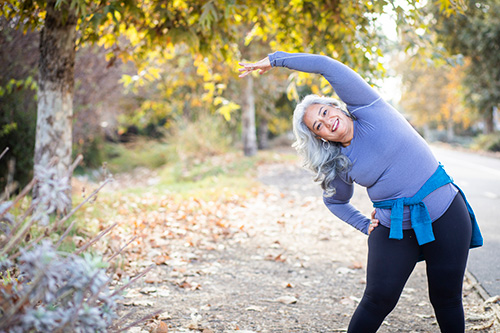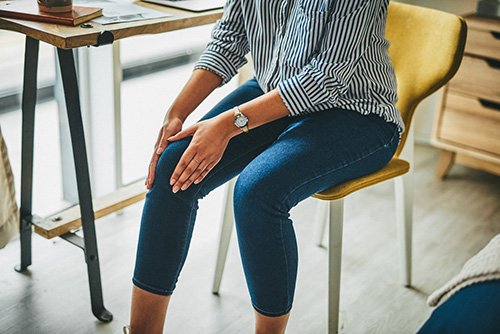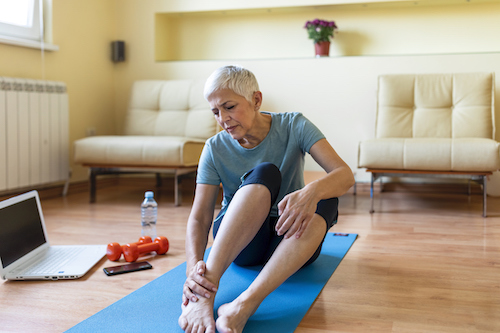Joint pain isn’t something you can forget about. You are always aware of it, even when you try to sleep at night. Achy, stiff and sore joints discourage you from doing what you want and may even stop you from getting the exercise you need to stay healthy.

Aches and pains are most commonly reported in the knees, shoulders and hips, but can also affect the neck, back, hands, ankles, feet and elbows. Joint pain in menopause or perimenopause is widespread and can make climbing stairs or walking short distances nearly impossible.
If you’re dealing with debilitating joint issues, you may be trying to manage with drugstore pain relievers. Those can help but recent research has discovered new solutions to consider. In most cases, you can relieve, or even stop, joint pain and swelling, and the ripple effect these can have on your quality of life.
What’s your joint issue?
- Pain and soreness
- Stiffness
- Tenderness
- Achiness
- Burning sensation
- Loss of mobility
- Weakness
- Swelling
- Rough, “grating” sensation
- Stabbing or pinching sensation
Main causes of joint pain in women
Your joints connect your bones which makes them especially vulnerable to injury, overuse and eventually osteoarthritis, when the protective cartilage becomes affected. While most joint issues develop over time, there may be a “tipping point” after which the pain and soreness quickly become almost unbearable.
Painful osteoarthritis is more common in women and can happen at any age — two thirds of sufferers are younger than 65. Additional factors that increase the risk of joint issues include obesity, repetitive-motion occupations, autoimmune conditions, injuries, bursitis, and gout.
X-rays can reveal cartilage loss or damage but conventional medicine doesn’t have a real answer for ongoing joint pain. However, there are new ways — powerful, natural options — that can help keep your joints flexible and reduce your discomfort and pain.
What’s causing your joint pain and stiffness?
The driving force behind joint pain is almost always inflammation — a key immune response that can bloom out of control. Many sources can feed inflammation, including previous, unhealed injuries at or near the painful joint. Sometimes the body realigns to accommodate an injury, and that adaptation can cause additional inflammation and pain.
The sex hormone imbalances that cause serious menstrual irregularities in younger women often lead to inflammation and bone health issues later on. Other hormone imbalances associated with adrenal dysfunction can produce sky-high cortisol levels that set off a pro-inflammatory cascade throughout your body. If the source isn’t shut down, destructive and chronic inflammation can continue indefinitely.
Inflammation often leads to swelling which presses or stretches tender nerve endings, sending pain signals shooting to the brain. But you may be unknowingly extending the chronic inflammation in your body simply by the way you live, and especially with the food you eat.
Stress is a sleeping giant when it comes to inflammation. If you stay stressed for a long time, your body pumps out cortisol, which fuels inflammation and causes additional problems. Sleep troubles of all kinds can lead to chronic inflammation, as can some allergies and sensitivities to foods and toxins. Add lack of exercise and hidden or long-term infections to the list as well.
Our approach…
We can help with many types of joint issues and our solutions will also benefit the rest of your body. If you know, or suspect, that your joints are seriously deteriorated, or if your joint cartilage, ligaments or tendons are damaged or missing, we recommend working with your doctor to find the right solution.
A simple joint health action plan for feeling better
Internal inflammation is particularly sneaky because you can’t see or feel it but you know it’s there with every ache and pain in your joints. Once the chronic inflammation process is underway it can be harder to deal with its effects. Identifying the source of your body’s inflammation can make a real difference for your joints, and the rest of your body.
Interrupting the chronic inflammation process that can silently wreak havoc on your joints is your best option for feeling better. You can address inflammation and help ensure good joint health in the future with three simple and natural steps:
- Eat — When you add more joint-friendly foods to your diet, it won’t take long before you’ll see, and feel, a measurable difference as you go about your day. Choose from an incredibly long list of delicious foods that are “alkaline,” or acid-neutralizing. Since we tend to eat lots of acid-forming foods, like meat and breads, swapping in alkalizing foods is an easy and effective way to support good joint health.
- Supplement — Science shows that certain combinations of targeted plant-derived ingredients can help with joint issues while supporting a healthy inflammatory response mechanism. Strong antioxidants, like quercetin, along with curcumin from turmeric, can help quiet inflammatory “noise” by disarming free radicals. Methylsulfonylmethane (MSM) has a long history of use for discomfort, and green-lipped mussel (Perna canalicula) has a funny name but its extracts promote good joint flexibility and mobility. Other key components known to help include bromelain, green tea extract and ginger.
- Flex — Using simple and very gentle physical activities to counteract joint pain and inflammation can change everything about how your joints feel from day to day. Slow, feel-good stretches help increase joint flexibility and improve mobility. At the same time, they help build muscle strength and lubricate the joints. Walking is a wonderful replacement as you cut back on high-impact exercise. You can devote more time to investigating yoga poses, or try t’ai chi. Both practices relieve stress as well, which is good for everything about your health.
The sooner you take action to improve your joint health, the better. For most joint health issues in women, taking the opportunity you have to improve how you feel now lowers the chance of things shifting the other way in the future.
https://www.cdc.gov/chronicdisease/resources/publications/aag/arthritis.htm
https://www.webmd.com/pain-management/guide/joint-pain
https://www.mayoclinic.org/diseases-conditions/osteoarthritis/basics/definition/con-20014749
https://www.mayoclinic.org/diseases-conditions/osteoarthritis/basics/tests-diagnosis/con-20014749
https://www.medicalnewstoday.com/articles/248423.php
https://www.webmd.com/vitamins-and-supplements/lifestyleGuide-11/alternatives-and-supplements-for-arthritis-joint-pain
Li G1, Fu Y2, Zheng J3, Li D4. Anti-inflammatory activity and mechanism of a lipid extract from hard-shelled mussel (Mytilus coruscus) on chronic arthritis in rats. Mar Drugs. 2014 Jan 27;12(2):568-88. doi: 10.3390/md12020568.https://www.ncbi.nlm.nih.gov/pubmed/24473164
https://umm.edu/health/medical/altmed/condition/rheumatoid-arthritis










